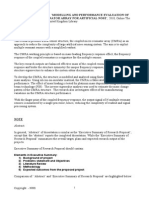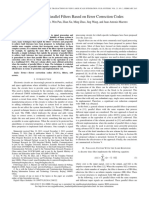Python Programming PART A Lab Manual
Uploaded by
thejas0716Python Programming PART A Lab Manual
Uploaded by
thejas0716Python Programming IV Sem Lab Manual
PART A
1. Perform the following operations on number list:
a) Sum
b) Average
c) Max
d) Min
e) Sort f) Reverse
# Input: List of numbers
numbers = [10, 20, 5, 8, 15, 25]
# a) Sum
total_sum = sum(numbers)
print("Sum:", total_sum)
# b) Average
average = total_sum / len(numbers)
print("Average:", average)
# c) Max
maximum = max(numbers)
print("Max:", maximum)
# d) Min
minimum = min(numbers)
print("Min:", minimum)
# e) Sort
sorted_list = sorted(numbers)
print("Sorted List:", sorted_list)
# f) Reverse
reversed_list = list(reversed(numbers))
print("Reversed List:", reversed_list)
Output:
Sum: 83
Average: 13.833333333333334
Max: 25
Min: 5
Sorted List: [5, 8, 10, 15, 20, 25]
Reversed List: [25, 15, 8, 5, 20, 10]
Abhishek A, ICIS Department, Srinivas University
2. Perform the following operations on string list:
a) Swap elements of string list
b) Combining two list
# Input: Two string lists
list1 = ["Dean", "HOD", "Professor"]
list2 = ["Mangaluru", "Kudla", "Dakshina Kannada"]
# a) Swap elements of string list
list1[0], list1[2] = list1[2], list1[0] # Swap first and last elements
print("List after swapping elements:", list1)
# b) Combine two lists
combined_list = list1 + list2 # Concatenating two lists
print("Combined List:", combined_list)
Output:
List after swapping elements: ['Professor', 'HOD', 'Dean']
Combined List: ['Professor', 'HOD', 'Dean', 'Mangaluru', 'Kudla', 'Dakshina
Kannada']
3. Perform matrix operations using NumPy
import numpy as np
x = np.array([[1,6],[8,35]])
y = np.array([[1,3], [2,7]])
print("The element wise addition of matrix is:")
print(np.add(x,y))
print("The element wise subtraction of matrix is:")
print(np.subtract(x,y))
print("The element wise division of matrix is:")
print(np.divide(x,y))
print("The element wise multiplication of matrix is:")
print(np.multiply(x,y))
print("The product of matrices is: ")
Abhishek A, ICIS Department, Srinivas University
print(np.dot(x,y))
Output:
The element wise addition of matrix is:
[[ 2 9]
[10 42]]
The element wise subtraction of matrix is:
[[ 0 3]
[ 6 28]]
The element wise division of matrix is:
[[1. 2.]
[4. 5.]]
The element wise multiplication of matrix is:
[[ 1 18]
[ 16 245]]
The product of matrices is:
[[ 13 45]
[ 78 269]]
4. Write a python program to find tuples which have all elements divisible by k from a
list of tuples
# Input: List of tuples and value of k
tuples_list = [(10, 20, 30), (12, 15, 18), (8, 16, 24), (7, 14, 21)]
k=5
# Filter tuples where all elements are divisible by k
result = [tup for tup in tuples_list if all(element % k == 0 for element in tup)]
# Output result
print("Tuples with all elements divisible by", k, "are:", result)
Output:
Tuples with all elements divisible by 5 are: [(10, 20, 30)]
Abhishek A, ICIS Department, Srinivas University
5. Write a python program for removing duplicates from tuples
x = input("Enter the value : ")
y = tuple(x)
print("The original tuple is : ")
print(y)
result = set (y)
print("The tuple after removing duplicates : ")
print(tuple(result))
Output:
Enter the value : MAASTHI AMMA
The original tuple is :
('M', 'A', 'A', 'S', 'T', 'H', 'I', ' ', 'A', 'M', 'M', 'A')
The tuple after removing duplicates :
('T', 'A', 'M', 'I', 'S', 'H', ' ')
6. Perform the following operations using NumPy:
a) Joining two arrays
b) Splitting arrays
c) Searching element
d) Sorting
e) Filtering
import numpy as np
# a) Joining two arrays
array1 = np.array([1, 2, 3])
array2 = np.array([4, 5, 6])
joined_array = np.concatenate((array1, array2))
print("Joined Array:", joined_array)
# b) Splitting arrays
split_array = np.array_split(joined_array, 3)
print("Split Arrays:", split_array)
# c) Searching element
search_element = 5
result = np.where(joined_array == search_element)
print(f"Element {search_element} found at index:", result[0])
# d) Sorting
unsorted_array = np.array([3, 1, 5, 2, 4])
sorted_array = np.sort(unsorted_array)
print("Sorted Array:", sorted_array)
Abhishek A, ICIS Department, Srinivas University
# e) Filtering
filter_condition = joined_array > 3
filtered_array = joined_array[filter_condition]
print("Filtered Array (elements > 3):", filtered_array)
Output:
Joined Array: [1 2 3 4 5 6]
Split Arrays: [array([1, 2]), array([3, 4]), array([5, 6])]
Element 5 found at index: [4]
Sorted Array: [1 2 3 4 5]
Filtered Array (elements > 3): [4 5 6]
7. Pandas with experiment
Create excel table of students using pandas having
1) USN
2) Name
3) M1
4) M2
5) M3
Calculate total and average and display result in table format
import pandas as pd
data = {
'USN': ['03SU23CC010', '03SU23CC068', '03SU23CC032', '03SU23DS019',
'03SU23DS022'],
'Name': ['AlRICK', 'SHREENIDHI', 'KALIDAS', 'SHARAN', 'VEEKSHITHA'],
'M1': [75, 82, 90, 65, 88],
'M2': [80, 72, 85, 70, 91],
'M3': [78, 84, 92, 68, 85]
}
df = pd.DataFrame(data)
df['Total'] = df['M1'] + df['M2'] + df['M3']
df['Average'] = df['Total'] / 3
print(df)
df.to_excel('student_marks.xlsx', index=False)
Output:
USN Name M1 M2 M3 Total Average
0 03SU23CC027 GOKUL 75 80 78 233 77.666667
1 03SU23CC068 SHREENIDHI 82 72 84 238 79.333333
2 03SU23CC032 KALIDAS 90 85 92 267 89.000000
3 03SU23DS019 SHARAN 65 70 68 203 67.666667
4 03SU23DS022 VEEKSHITHA 88 91 85 264 88.000000
Abhishek A, ICIS Department, Srinivas University
You might also like
- Basic_Operations_With_Examples_Python_Lists_Tuples_Sets_With_DictionariesNo ratings yetBasic_Operations_With_Examples_Python_Lists_Tuples_Sets_With_Dictionaries7 pages
- Breaking Barriers: Micro-Mortgage AnalyticsNo ratings yetBreaking Barriers: Micro-Mortgage Analytics121 pages
- Write A Numpy Program To Reverse An Array (First Element Becomes Last)No ratings yetWrite A Numpy Program To Reverse An Array (First Element Becomes Last)8 pages
- OCS353-Data Science Fundamentals Manual 1No ratings yetOCS353-Data Science Fundamentals Manual 134 pages
- Lecture - 1 - System of Linear Equations - Matrix Algebra-Part1No ratings yetLecture - 1 - System of Linear Equations - Matrix Algebra-Part120 pages
- Spectrum Estimation and Analysis: Dept of BME, KUET Sub: BME 3111 1No ratings yetSpectrum Estimation and Analysis: Dept of BME, KUET Sub: BME 3111 147 pages
- Rethinking Optical Flow From Geometric Matching Consistent PerspectiveNo ratings yetRethinking Optical Flow From Geometric Matching Consistent Perspective17 pages
- 2.fault Tolerant Parallel Filters Based On Error Correction CodesNo ratings yet2.fault Tolerant Parallel Filters Based On Error Correction Codes4 pages
- AIF-C01 Updated Dumps - AWS Certified AI PractitionerNo ratings yetAIF-C01 Updated Dumps - AWS Certified AI Practitioner23 pages
- 66_PDFsam_Digital signal processing. Fundamentals and applications by Jiang, Jean Tan, Li (z-lib.org)No ratings yet66_PDFsam_Digital signal processing. Fundamentals and applications by Jiang, Jean Tan, Li (z-lib.org)25 pages
- DR: Hossam Elden Talaat: Name: Mohamed SalahNo ratings yetDR: Hossam Elden Talaat: Name: Mohamed Salah23 pages
- An Efficient Hardware Architecture For Exploiting Sparsity in Neural Networks Master ThesisNo ratings yetAn Efficient Hardware Architecture For Exploiting Sparsity in Neural Networks Master Thesis63 pages
- Artificial Intelligence and Machine LearningNo ratings yetArtificial Intelligence and Machine Learning62 pages
- simulation of time series models practs-1No ratings yetsimulation of time series models practs-110 pages
























































































